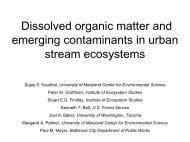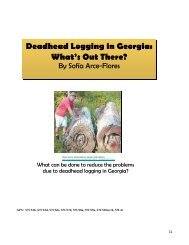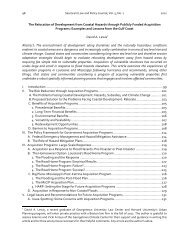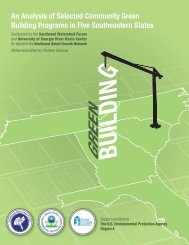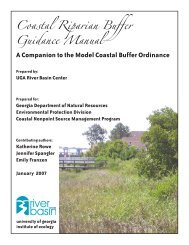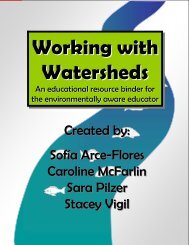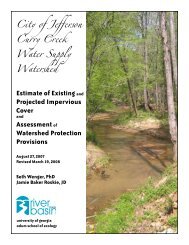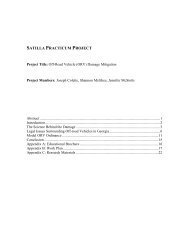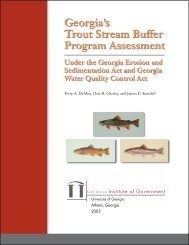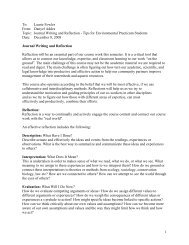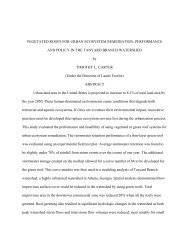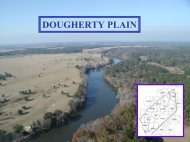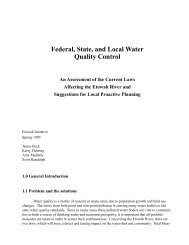1 Bibliographic Review of Sources Relevant to Development of Draft ...
1 Bibliographic Review of Sources Relevant to Development of Draft ...
1 Bibliographic Review of Sources Relevant to Development of Draft ...
Create successful ePaper yourself
Turn your PDF publications into a flip-book with our unique Google optimized e-Paper software.
Savannah River Annotated Bibliography: January 2003<br />
duck production in the southeastern Atlantic coastal plain." Wildlife society<br />
Bulletin 29: 1193-1205.<br />
Wetland hydrologic conditions were positively associated with wood duck productivity. Wet<br />
years provided a longer breeding season and reduced predation.<br />
Straney, D., L. Briese and M. Smith (1974). "Bird diversity and thermal stress in a<br />
cypress swamp." Thermal Ecology: 572-578.<br />
Birds respond <strong>to</strong> the structural changes bought on by aquatic stress. Formation <strong>of</strong> canopy gaps,<br />
presence or absence <strong>of</strong> underbrush, or standing deadwood influence the bird species diversity and<br />
abundance. Burke, V. J., J. E. Lovich and J. W. Gibbons. 2000. Conservation <strong>of</strong><br />
freshwater turtles. Turtle Conservation. M. Klemens. Washing<strong>to</strong>n, DC,<br />
Smithsonian Institution Press. pp. 156-179.<br />
This chapter in the book Freshwater Turtles discusses conservation <strong>of</strong> turtles in regards <strong>to</strong> life<br />
cycle, describes the status <strong>of</strong> freshwater turtles, and provides recommendations for future<br />
conservation efforts. Preservation <strong>of</strong> habitat is a critical fac<strong>to</strong>r in maintaining a population.<br />
Freshwater turtles frequently require upland habitat for nesting, overwintering, and foraging so<br />
protection <strong>of</strong> land adjacent <strong>to</strong> the wetland is essential. Juvenile turtles have different prey items<br />
and change habitat as they grow in size. As a result, a spatially heterogeneous freshwater<br />
environment is needed <strong>to</strong> provide the various requirements for the maturing turtles.<br />
Recommendations include ending human exploitation (recreational shooting and wild capture for<br />
the pet trade,) preservation <strong>of</strong> lentic waters, and educational programs for the public.<br />
Gibbons, J., V. Burke, J. Lovich, R. Semlitsch, T. Tuberville, J. Bodie, J. Greene, P.<br />
Niewiarowski, H. Whiteman, D. Scott, J. Pechmann, C. Harrison, S. Bennett, J.<br />
Krenz, M. Mills, K. Buhlmann, J. Lee, R. Seigel, A. Tucker, T. Mills, T. Lamb,<br />
M. Dorcas, J. Congdon, M. Smith, D. Nelson, M. Dietsch, H. Hanlin, J. Ott and<br />
D. Karapatakis (1997). "Perceptions <strong>of</strong> species abundance, distribution, and<br />
diversity: lessons from four decades <strong>of</strong> sampling on a government-managed<br />
reserve." Environmental Management 21(2): 259-268.<br />
This article reviews data compiled on over one million captures or observations <strong>of</strong> 98 species over<br />
a 44-year study period on the SRS. Perceptions <strong>of</strong> species diversity are dependent on level <strong>of</strong><br />
effort during data collection. Short-term databases used for management decisions could result in<br />
serious error. Recommendations include training data collec<strong>to</strong>rs in field recognition <strong>of</strong> more than<br />
one taxonomic species. Efforts should be made <strong>to</strong> measure the status <strong>of</strong> populations quantitatively<br />
using consistent and reliable methodologies.<br />
Lee, J., V. Burke and J. Gibbons (1997). "Behavior <strong>of</strong> hatchling Alliga<strong>to</strong>r<br />
mississippiensis exposed <strong>to</strong> ice." Copeia 1997(1): 224-226.<br />
This study on the SRS indicates that alliga<strong>to</strong>rs are able <strong>to</strong> survive temporary icing by maintaining<br />
a breathing hole and taking advantage <strong>of</strong> water temperature gradients. Water depth must be<br />
sufficient for the animals <strong>to</strong> submerge in an inclined position with only their snouts above the<br />
water.<br />
Mills, M., C. Hudson and H. Berna (1995). "Spatial ecology and movements <strong>of</strong> the<br />
brown water snake (Nerodia taxispilota)." Herpe<strong>to</strong>logica 51: 412-423.<br />
This article reveals movement patterns and habitat preferences for the brown water snake. A<br />
preference was identified for the steep, outside bends <strong>of</strong> the river. A majority (70%) <strong>of</strong> recaptures<br />
were found within 250 m <strong>of</strong> their previous capture site and only the largest snakes actually crossed<br />
the river. These results are significant <strong>to</strong> the Savannah River ecological flow study because<br />
portions <strong>of</strong> the river have been straightened and the preferred habitat <strong>of</strong> these snakes destroyed.<br />
18




